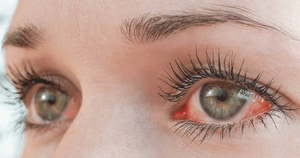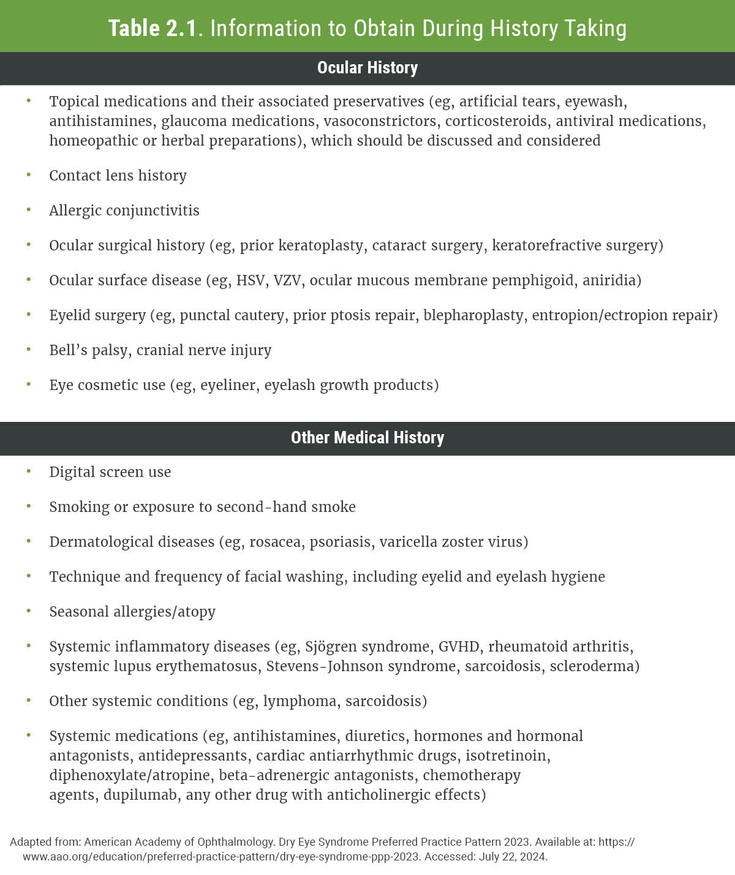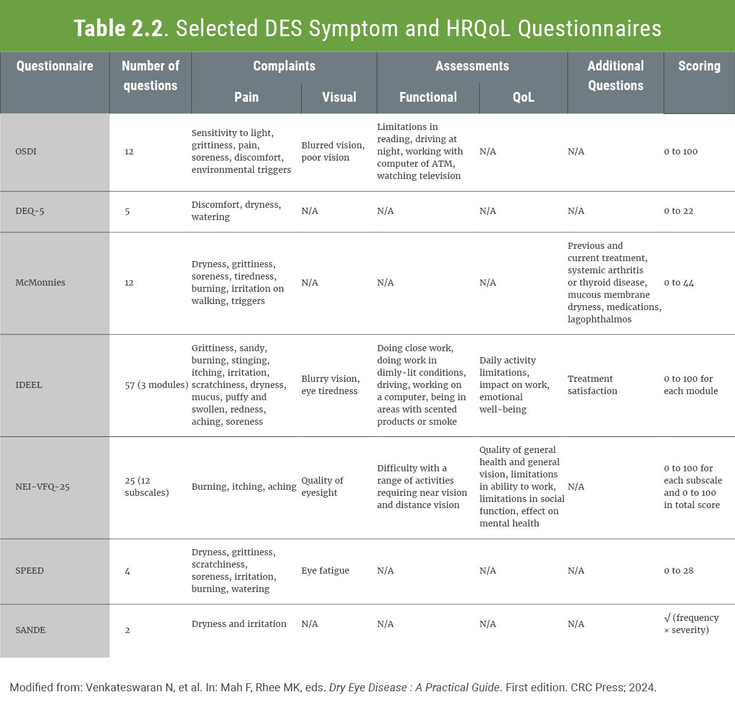Presentation and Patient History
Presentation
Reflecting its myriad etiologies (see Etiology and Classification), dry eye syndrome (DES), has a heterogeneous manifestation, with presenting symptoms including foreign body sensation, irritation, pain, photophobia, tearing and blurred or fluctuating vision. Although typically bilateral, DES can occur unilaterally, for example in cases of unilateral infection or intracranial lesion. Tearing as a symptom may appear paradoxical but represents reflex tear production triggered by ocular surface irritation, which can provide temporary relief.
Patient History and Symptom Questionnaires
Diagnosis of DES relies both on symptomatology and on tests for objective signs. Since clinical findings often underestimate the severity of DES and its impact on quality of life (QoL), ophthalmologists often rely considerably on patient history and symptom questionnaires that quantify symptoms. In addition to presenting symptoms, a clinician should obtain information on any potential exacerbating…
To continue reading
Log in or register to continue reading. It's free!
OR
By signing up to create an account, I accept Healio's Terms of Use and Privacy Policy.
Presentation
Reflecting its myriad etiologies (see Etiology and Classification), dry eye syndrome (DES), has a heterogeneous manifestation, with presenting symptoms including foreign body sensation, irritation, pain, photophobia, tearing and blurred or fluctuating vision. Although typically bilateral, DES can occur unilaterally, for example in cases of unilateral infection or intracranial lesion. Tearing as a symptom may appear paradoxical but represents reflex tear production triggered by ocular surface irritation, which can provide temporary relief.
Patient History and Symptom Questionnaires
Diagnosis of DES relies both on symptomatology and on tests for objective signs. Since clinical findings often underestimate the severity of DES and its impact on quality of life (QoL), ophthalmologists often rely considerably on patient history and symptom questionnaires that quantify symptoms. In addition to presenting symptoms, a clinician should obtain information on any potential exacerbating conditions, including air travel, low humidity, air drafts (from fans or vents), prolonged visual efforts (reading, use of electronic devices) and poorly fitted sleep apnea devices. Patients should also be asked about the duration of symptoms and the use of artificial tears for symptom relief. Additional potentially informative history includes chronic conditions (Sjögren syndrome, rheumatoid arthritis, or chronic systemic graft-versus-host disease (GVHD)), bariatric surgery or malnutrition (which may be associated with vitamin A deficiency), eyelid malposition (e.g., Bell’s palsy) which may lead to incomplete lid closure, and use of medications associated with aqueous tear deficiency (e.g., diuretics, antihistamines and antidepressants). This and other potentially relevant information that should be obtained during ocular or general medical history taking is shown in Table 2-1.
At least 17 questionnaires have been developed to obtain information about the symptoms and health-related QoL (HRQoL) of patients with DES or suspected DES. Most questionnaires were developed for and are primarily used in clinical or epidemiological studies. However, several are also useful for completing history taking in clinical practice, including OSDI, DEQ-5, SPEED and several others (see Table 2-2).
The Ocular Surface Disease Index (OSDI) is one of the most frequently used DES symptom assessment tools. The OSDI is a 12-item questionnaire, with questions about the presence of symptoms, their timing and frequency during vision-related activities over the preceding week, and their occurrence in conjunction with environmental triggers. Each item on the OSDI is graded on a scale of 0-4 (0 indicating none of the time; 1, some of the time; 2, half of the time; 3, most of the time; and 4, all of the time). The OSDI score is then calculated using the following formula:
(sum of the scores of all questions answered × 100)/(total number of questions answered × 4)
Possible scores range from 0 to 100, with higher scores indicating greater disability. Scores of 13-22, 23-32 and ≥33 are indicative of mild, moderate and severe DES, respectively.
The Dry Eye Questionnaire (DEQ)-5 is a 1-page, 5-question subset of the larger DEQ questionnaire. It includes two questions on eye discomfort (on the frequency in the past month with scores of 0 [never] to 4 [constantly] and on the intensity of the discomfort scored from 0 [no discomfort] to 5 [very intense discomfort]), two questions on eye dryness (on its frequency on a typical day and the intensity of dryness, scored in the same way eye discomfort questions) and one question on the frequency of watery eyes on a typical day in the past month (scored from 0 [never] to 4 [constantly]). The total DEQ-5 score is simply the sum of the scores for each individual question. A score of ≥6 warrants further clinical testing to establish DES and that of ≥12 testing to rule out Sjögren syndrome.
The Standard Patient Evaluation of Eye Dryness (SPEED) is a 4-question survey questionnaire that collects information about the presence (current, past 72 hours, past 3 months), frequency (0, never; 1, sometimes; 2, often; and 3, constant) and severity (0, no problems; 1, tolerable; 2, uncomfortable; 3, bothersome; 4, intolerable) of four DES-associated symptom groups (dryness, grittiness, or scratchiness; soreness or irritation; burning or watering; eye fatigue) and whether the patient uses eye drops for lubrication (and how often). The total SPEED score ranges from 0 to 28 and is calculated as the sum of the total frequency and severity scores. A score of 1-9 indicates mild to moderate symptoms while a score of 10 or higher indicates severe symptoms.
References
- Bron AJ, de Paiva CS, Chauhan SK, et al. TFOS DEWS II pathophysiology report [published correction appears in Ocul Surf. 2019 Oct;17(4):842.
- Chalmers RL, Begley CG, Caffery B. Validation of the 5-Item Dry Eye Questionnaire (DEQ-5): Discrimination across self-assessed severity and aqueous tear deficient dry eye diagnoses. Cont Lens Anterior Eye. 2010;33(2):55-60.





